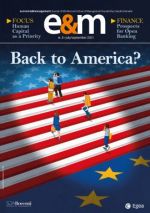E&M
2022/4
The Virtuous Circle of Sustainability
The issue of sustainability in real estate is on everyone’s lips, but there is still much uncertainty about how ESG criteria can be applied and how their value can be measured. The only belief shared by all stakeholders is that sustainability should be a key element of any urban regeneration project; because it is only by respecting and integrating environmental and social dimensions into business strategies that wealth and wellbeing can be created for businesses and people working and living in regenerated experiential districts.
Paragraph Title
The issue of sustainability in real estate is on everyone’s lips, but there is still much uncertainty about how ESG criteria can be applied and how their value can be measured. The only belief shared by all stakeholders is that sustainability should be a key element of any urban regeneration project; because it is only by respecting and integrating environmental and social dimensions into business strategies that wealth and wellbeing can be created for businesses and people working and living in regenerated experiential districts.
Why has academic literature not yet developed a definitive stance on the impact of sustainability on the economic value created by companies across all industries? Probably because there still exists a significant heterogeneity in terms of how to conceptualize, measure and approach sustainability. One assumption is that sustainability can be achieved by improving ESG criteria. Companies and institutions with good governance reduce agency problems and increase transparency (although they can make life very difficult for managers, who need to determine what goals various actions are pursuing). Moreover, taking environmental and social impact into account should reduce negative external costs and boost positive ones. However, at the conceptual and definition level, we are still experiencing what economic literature refers to as “aggregate confusion.” Internationally, we have the 17 Sustainable Development Goals of the United Nations, the 8 Millennium Development Goals of the World Bank, and the Green Deal promoted by Europe, which is also creating environmental and social taxonomies. The situation in the business sphere is not much better. The correlation between ratings provided by various private agencies to corporations and financial institutions is generally 60%, in this case mainly due to different measurement methods.
What framework is there for urban regeneration?
Sustainable Responsible Investing (SRI) integrates long-term ESG criteria into the business and project mission. The business plan should, therefore, include the social and environmental parameters of sustainability. In reflecting on the implications of this for real estate in general and for urban regeneration in particular, it is worth taking a look at the fundamentals of any investment project, namely, the cash flows expected over a given time horizon, discounted to appropriate rates that take into account the “cost” of time and the “cost” of risk. Considered in the simple conceptual framework of discounted cash flows, urban regeneration projects may be considered the Mount Everest of real estate. The period of time that elapses between conceiving the idea, implementing it, and making the final sale is often measured in decades, not years. Just think of the projects conceived in the 1990s and executed ten years later; in the subsequent years, they faced – in rapid succession – the most serious financial crisis in history in 2007, the most serious sovereign debt crisis in 2010-2012, the worst pandemic in modern times in 2020, and now a war on a scale unseen in Europe for the past seventy-seven years. What will the urban regeneration projects currently being developed have to deal with in the next forty years? We could dwell on a list of possible incidents that might be encountered along the way, but this would not be useful in discussing a possible framework for sustainability. It would be more worthwhile, instead, to note what drivers determine the value of an urban regeneration project and how they incorporate ESG parameters.
Cash flows
The impact of sustainability on cash flows may be broken down into several elements. Value creation in urban regeneration projects only takes place if the various functions of real estate are integrated synergistically, creating experiential districts for the people who work in and inhabit new spaces. Real estate needs to be seen not only as a “commodity” but also as part of an ecosystem in which to “live certain experiences” (connected with shopping, work, leisure, etc.), and in which households and businesses can benefit from certain services. Private spaces for public use should guarantee the wellbeing of the community, thus creating intangible value. However, how can urban regeneration projects create sustainable cash flows? In the project mission, the wellbeing of the community, and thus the construction of a value proposition supporting the needs of the local communities, are the levers for the development of (new) urban regeneration projects. An increase in the top line of the profit and loss statement (revenue) will depend on:
- the ability of the product offered to meet new needs by addressing a replacement market and by increasing market share (e.g. a new concept of homes including services for families: co-working areas, gyms, nurseries, playgrounds, etc.);
- the new demand stemming from organic demographic growth and/or from the attractiveness of the project generated through “anchors” that generate new housing and work needs (see Milan’s Human Technopole, the life sciences research institute that promotes innovation in the health sector under the MIND project).
Another aspect of the impact of sustainability on cash flows is profitability, measured in terms of earnings after tax in relation to revenues. In the era of real estate as a service, profitability springs from the player’s capacity for efficient management, achieved through economies of experience (hence the need for professional operators to handle the complex management of entire neighborhoods) and economies of scale (for example, to make living and housing services accessible), and by industrializing the provision of services to people and households also through the enabling factor of technology. The third aspect of long-term sustainability is Sustainable Return of Investment (SROI), that is, the ability of an investment to be efficient in terms of the extra euros generated per euro of capital invested, also taking into account, in the expected cash flow, the economic value of social and environmental dimensions for all stakeholders. The investments needed to support the economic continuity and growth of real estate that promotes wellbeing should be considered broadly: not only maintenance investments, therefore, but also Capital Expenditure (CapEX) in new infrastructure to ensure the long-term viability of the asset, even beyond the business plan period. Reinvestments required during the project lifecycle derive from a precise asset management strategy, which should be holistic and proactive, and involve a coordinated management of urban areas (for example, the management of super condominiums), which need to be flexible enough to adapt the assets to fluctuations in demand.
Discount rates and leveraging risk
As mentioned earlier, the time horizon in urban regeneration projects can be very long. Taking into account the urbanization, building and management phases, the overall project risk – as for companies in other sectors – can be broken down into two types of risk:
- management risk during periods of business continuity (when the asset is up and running);
- operational risk associated with discontinuous phases (start-up and decline).
The operational and financial risks of the management phase (in the perspective of business continuity) measure uncertainties about future revenues and operating income, as reflected in the cost of capital; cash flows being equal, a higher expected cost of capital will lead to a decrease in the value of the project. The project may also fail to ensure business continuity, and the probability of this happening is particularly high during two crucial and difficult stages: the initial start-up phase and the final phase leading to the sale of the asset or, in any case, the end of the investment lifecycle. We see this increased danger as a risk of failure, which is higher during discontinuous phases and leads to a decrease in value. It is difficult to know what the potential needs of demand may be in a few decades’ time (that is, the needs of the end buyer), especially in a dynamic environment such as the one outlined above, but it is important to know how to manage the immediate start-up phase. This phase is crucial in order to design and implement flexible projects capable of taking on board the new and changing needs of end users during the management phase; and it is also important in order to address, right from the start, the issue of the value of the asset at the end of the business plan period (its final value), in economic terms, but also in terms of its social and environmental impact. For a decade now, academic research has been trying to understand whether sustainable projects/companies could benefit from lower discount rates. The average response of many papers on the subject is that an impact does exist: sustainability champions enjoy lower rates, in terms of both banking loans and returns expected by shareholders. Why should these rates be lower? This is due to two basic drivers. Given that ESG parameters contribute to the creation of economic value, providers of capital clearly perceive a lower risk when the debtor adopts a broad view of management, inclusive of sustainability issues. The second driver is the social mission of the lender: institutions that are willing to sacrifice the individual good for the collective good turn their attention to a subset of virtuous companies, which thus enjoy a higher influx of funding and benefit from lower costs. In our opinion, the 0.5% reduction often detected in the literature (except in the case of green bonds, where there seems to be no difference) should not be overestimated, both because of inevitable statistical measurement errors and because of the dynamic nature of the phenomenon. It would be more important to look at the instruments by which, for example, financing contracts (debt capital injections) make the reduction of the cost of debt conditional on achieving specific, measurable environmental goals (e.g. green loans) and social objectives (e.g. sustainability bonds).
The virtuous circle of sustainability
Growth, risk, investment efficiency, and profitability are drivers that determine whether the value of a project is sustainable. Cornell and Damodaran use this framework to analyze three future scenarios and to understand the impact of sustainability. In the first two (positive) scenarios, green firms beat brown ones, either because the economic community rewards the greater ability of the former to create economic value (virtuous scenario) or because it wants to punish the latter (punitive scenario), for example by not buying their goods and services. The third (dystopian) scenario predicts a victory for brown firms. While some of the recent phenomena (such as the return to coal caused by the absence of gas) are compatible with this scenario, we believe that in the long term this is merely a residual possibility, partly due to the influence of regulators and policymakers.
The most sought-after model is undoubtedly the virtuous circle. Creating a sustainable value proposition and managing projects by measuring their economic and ESG impact generates benefits right across the board. The cost being equal, customers – attracted by the social mission and by increased services – reward virtuous projects, thus increasing their market share and the revenues of an affordable service/commodity. While sustainability requires greater investment and creates higher short-term operating expenses, the project cost structure adapts to the new regulations, allowing for unchanged or even higher profit margins in the long term and higher value for all stakeholders. Leading urban regeneration players and stakeholders, such as developers, banks, and strategic advisors, identify the virtuous circle of sustainability as a must-have, in order to achieve projects that are profitable, and more. Indeed, it is an additional value to be reported and potentially added to the real estate value derived from the location and physical characteristics of the asset.





